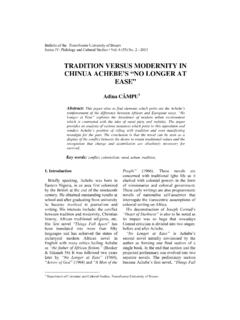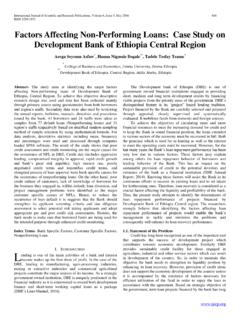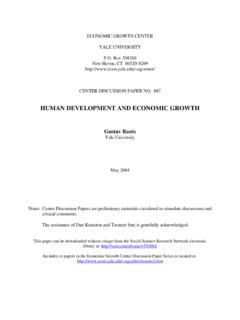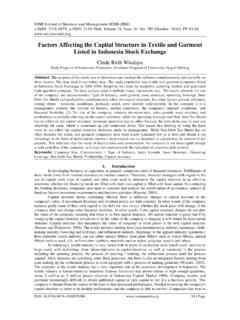Transcription of The main determinants affecting economic growth
1 Bulletin of the Transilvania University of Bra ov Series V: economic Sciences Vol. 8 (57) No. 2 - 2015. The main determinants affecting economic growth Florin Teodor BOLDEANU1, Liliana CONSTANTINESCU2. Abstract: growth theories highlight the evolution and trends in economic thought that shaped the way economic growth is perceived. From the early works of Adam Smith and Malthus to the present day researchers have tried to find the most important determinates that influence growth by formulating new and improved theories and models. In this article we try to offer our point of view in the evolution of the main factors that have an impact on economic growth . There is still not a consensus on the key determinants of growth and an all-encompassing model that includes all the influences has not yet been elaborated. Key-words: economic growth , public expenditure, growth theory 1. Introduction economic growth theories and models highlight the different ways in which the present economic activity can have an influence on future economic developments and can also identify sources that may lead to continued economic growth .
2 Researchers and economists reaffirm the need for economic growth for the evolution and well been of the human race. The economic growth theories have evolved over time depending on the period and on the dynamics of economy. Also improvements in mathematical and statistical tools have had a significant impact in formulating new concepts. Why do we need economic growth ? What are the main factors that foster growth ? Many researchers, economists and Nobel Prize winners tried to answer these questions. economic growth can be considered a main factor in the well being and prosperity of billions of people. Industrialization and advances in technology has left a gap between developed countries and poorer ones. For example now, in the 21st century the GDP/capita of many poorer countries is lower than the GDP per capita of Europe in the 19th century. economic growth was a pinnacle of the 20th century that insured the development of the Western World and improved for many people the leaving standards.
3 1. Lucian Blaga University of Sibiu, 2. Christian University, Bucharest, 330 Florin Teodor BOLDEANU, Liliana CONSTANTINESCU. 2. The economic growth concept Denison (1962) affirmed that economic growth is the increase of real GDP or GDP. per capita, an increase of national product that is measured in constant prices. economic growth is influences by direct factors like for example human resources (increasing the active population, investing in human capital), natural resources (land, underground resources), the increase in capital employed or technological advancements. economic growth is also influenced by indirect factors such as institutions (financial institutions, private administrations etc.), the size of the aggregate demand, saving rates and investment rates, the efficiency of the financial system, budgetary and fiscal policies, migration of labour and capital and the efficiency of the government.
4 There are four major determinants of economic growth : human resources, natural resources, capital formation and technology, but the importance that researchers had given each determinant was always different. Renowned economists provided, over time, the most basic ingredients which appear in modern theories of economic growth . 3. determinants of economic growth The determinants of economic growth are inter-related factors influencing the growth rate of an economy. There are six major factors that determine growth with for of them been grouped under supply determinants and the other two are efficiency and demand. The four supply factors are natural resources, capital goods, human resources and technology and they have a direct effect on the value of good and services supplied. economic growth measured by GDP means the increase of the growth rate of GDP, but what determines the increase of each component is very different.
5 Public expenditure, capital formation, private or public investment, employment rates, exchange rates etc. have different impacts on economic growth and we should take into account that these determinants have different implications if the states are developed or not. There are also socio-political factors and events that have a major influence on the economic advancement of a country. There are also differences between economic and non- economic determinants . Proximate or economic determinants refers to factors like capital accumulation, technological progress, labour and ultimate or non- economic sources refers to factors like government efficiency, institutions, political and administrative systems, cultural and social factors, geography and demography (Acemoglu, 2009). The main determinants of economic growth 331. Public expenditure There are many conflicting views regarding the effects of public expenditure on economic growth .
6 Ghosh and Gregoriou (2008) and Benos (2009) had different outcomes even if they used the same methodology (the generalized method of moments). Ghosh and Gregoriou (2008) showed that the current component of public spending had a significant and positive effect on growth for a sample of 15 developing countries. Meanwhile, Benos (2009) affirmed that infrastructure and human capital had a significant effect on long-run growth for a group of 14 EU states. Lamartina and Zaghini (2008), Arpaia and Turini (2008), Szarowsk (2012), tested the link between public spending and economic growth using the Wagner's law. For example the results of the analysis made by Lamartina and Zaghini (2008). confirmed Wagner's theory, because the public expenditure elasticity coefficient compared to GDP takes values above par. The analysis also concludes that the expected long-term elasticity coefficient values are higher in countries with lower GDP per capita, suggesting an attempt to realize economic development funded by the state.
7 Szarowsk (2012) analyzed the direct link between public spending and output (GDP) in short and long-term for Bulgaria, Czech Republic, Hungary, Romania and Slovakia and also investigated if public spending is countercyclical. Her results reject the countercyclical effect of the two variables. Many recent papers for OECD, developing countries, Latin America showed that contrary to the theory, public spending is pro cyclical (Alesina et al. 2008; Abbott and Jones, 2011). The literature also emphasized the importance of education on growth . We consider that a grate contribution to this subject was made by researchers like Barro (1991), Sala-i-Martin et al. (2004). Also education is a key measurement tool and proxy for the quality of human capital in the sense that educated and skilled workers can have an important contribution to production and growth . Benoit (1978), Pieroni (2009), Ho and Chen (2014) investigated the influence of military spending on economic growth .
8 Many researchers concluded that defence spending has a negative effect on growth . Benoit (1798) was the pioneer in his field and found that for less developed states military spending had a positive effect on economic growth . The assumption that this component of public spending can have a positive effect depends on the samples, the different theoretical specifications and the time period. McDonald and Eger (2010) affirmed that defence expenditure had a small or rather insignificant effect on economic growth . On the other hand Pieroni (2009), Ho and Chen (2014) concluded that military expenditure has a negative influence on economic growth . Boldeanu and Tache (2015) analysed for 30 European countries the correlation between public spending and growth using the COFOG methodology. They disaggregated each component of public expenditure into their sub- classification and used 3 statistical methods for analysis the impact of public 332 Florin Teodor BOLDEANU, Liliana CONSTANTINESCU.
9 Spending on growth . The results showed that most of the government expenditures had a negative impact on economic growth . Trade components and FDI. There are numerous research papers that analyzed the link between FDI and trade components (exports, imports openness, trade restrictions) and growth . A big number of papers have shown that states that have economies open to trade have higher per capita GDP and grow much faster (Romer, 1990; Barro, 2003). Tekin (2012) found that a raise in exports has a positive effect on growth . Sultan and Haque (2011) and Simu and Me ter (2014) determined a long-term and direct influence between some trade determinants on economic growth . Simu and Me ter (2014) identified a direct correlation and causality between exports, openness and economic growth for 10 East European states and Sultan and Haque (2011) found that there is a long-run relationship between exports and growth for India.
10 The influence of trade on economic growth in the Middle East has been analysed by many researchers. AL- Raimony (2011) investigated the relationship between real export and real import growth and economic growth in Jordan. He concludes that real export growth positively affects growth , while real import growth negatively affects economic growth . In 2014 Abu-Eideh analyzed real domestic exports and imports of goods and services and how they affect real gross domestic product in Palestine (Abu-Eideh 2014). He stated that real domestic exports have a positive impact on growth in Palestine while real domestic imports a negative one. Openness can have an important influence on economic growth through a multitude of different channels like through technological transfers, competitiveness advantage and increase in economies of scale (Chang et al. 2009). Edward (1992). showed that trade openness has a favourable effect on real GDP and that trade liberalization will accelerate economic growth and countries will be capable to enter more easily foreign markets.








